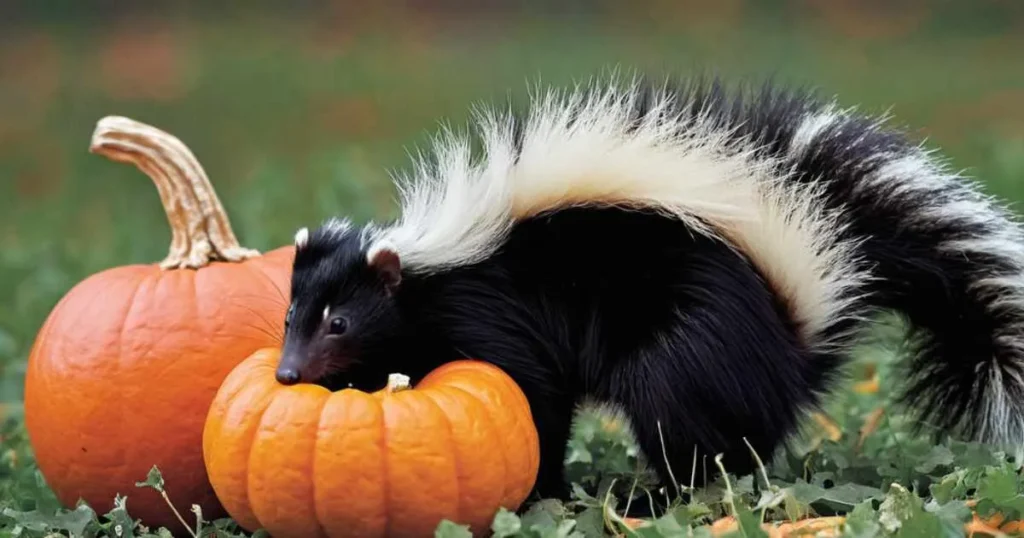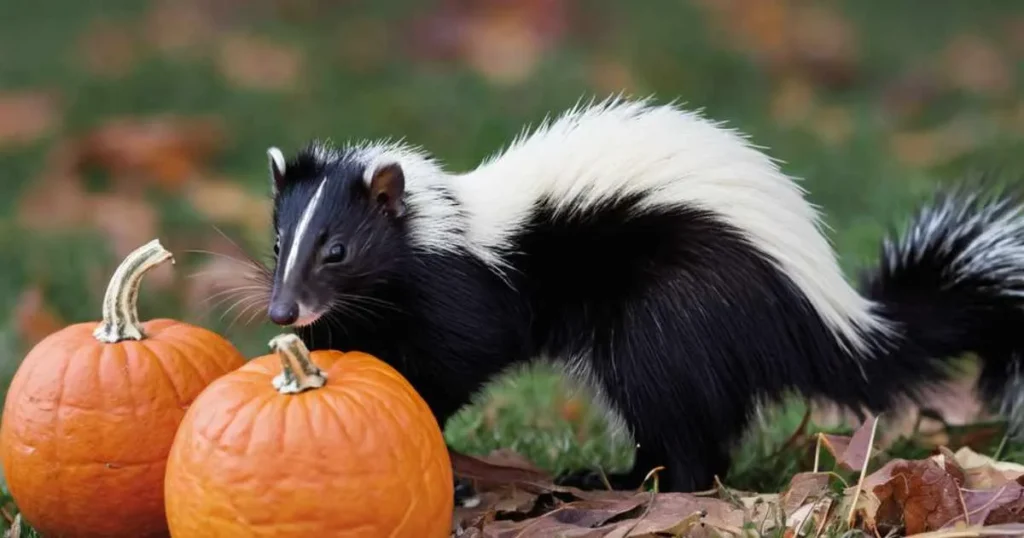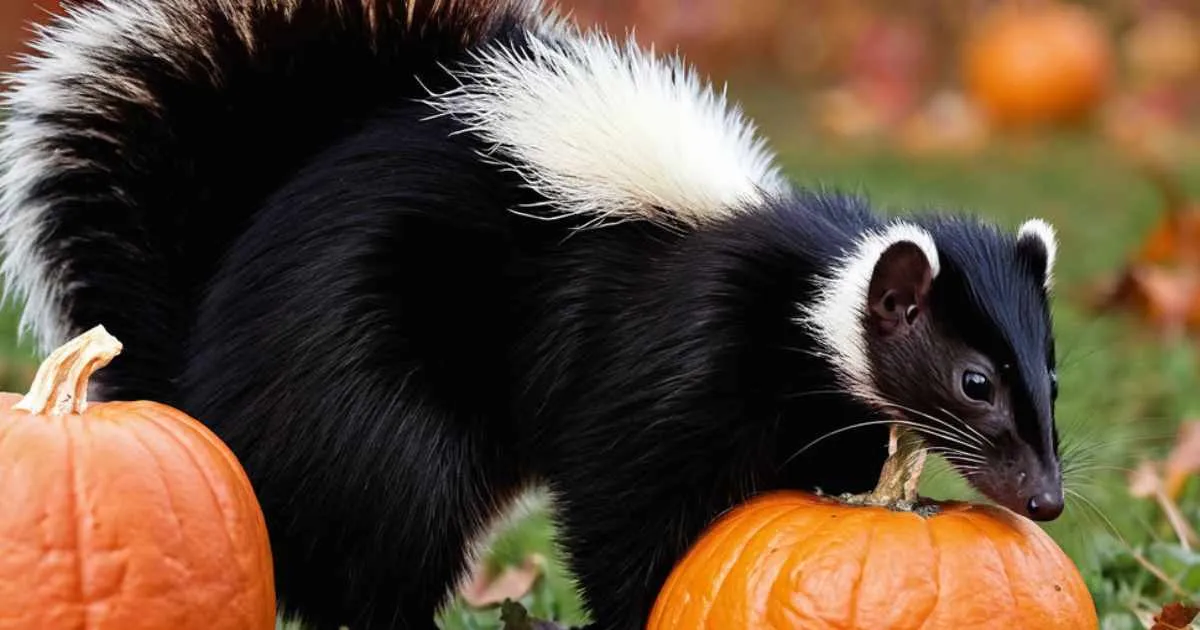Can Skunk Eat Pumpkins? (& Is It Healthy?)
Last updated on November 4th, 2024 at 06:32 am
From my experience as a skunk pet owner and wildlife researcher, I’ve noticed skunks have quite an appetite for pumpkins during the fall. Their black and white fur might be famous, but their sneaky nighttime raids on pumpkin patches can surprise gardeners. Want to know how to keep your pumpkins safe from these furry foragers? Read on to discover some effective tips!
The Skunk Diet Basics
Skunks are known for their black and white stripes and their ability to spray a strong odor. But what do these nighttime foragers eat? Let’s dive into the basics of a skunk’s diet. These creatures have diverse dietary preferences, adapting to various foods found in their habitat.
Natural Food Sources
In the wild, skunks have a rich diet that consists mostly of insects and small mammals. Their natural food choices include:
- Beetles
- Grubs
- Earthworms
- Mice
- Berries
These foods provide skunks with the necessary nutrients for their daily activities. Fruits and vegetables can also be part of their diet, depending on availability.
Opportunistic Feeding Habits
Skunks are opportunistic feeders. This means they eat whatever is easily accessible. In areas near humans, their diet can include:
- Leftover pet food
- Garbage scraps
- Garden produce
Pumpkins, when available, can be a food source for skunks. They might nibble on these large Apple fruits, especially when other food is scarce.
Pumpkins As Potential Food
Imagine a crisp autumn night and a sleek, black-and-white skunk shuffles through fallen leaves. It sniffs around, searching for a tasty treat. Pumpkins, often thought of as purely decorative or for human consumption, can catch the eye of foraging skunks. These creatures are opportunistic eaters, and pumpkins offer a nutritious snack that can add variety to their diet. This might raise your curiosity about what makes pumpkins good for skunks and when they have access to such treats.

Nutritional Value Of Pumpkins
Pumpkins are rich in vitamins, minerals, and fiber, which are important for a skunk’s health. Here’s a quick look at the nutritional benefits they offer:
- Vitamin A – is vital for good vision.
- Fiber – aids in digestion.
- Antioxidants – help fight disease.
Not only do pumpkins contain valuable nutrients, but they also have soft flesh that is easy for skunks to eat. Even the seeds can be a good source of protein for these critters.
Seasonal Availability For Skunks
Skunks have keen senses that lead them to pumpkins, particularly in the fall. This table summarizes when pumpkins became a food option for skunks:
| Season | Availability |
|---|---|
| Fall | High |
During the autumn months, pumpkins are abundant. Gardens, farms, and even porch decorations become potential dining spots. After Halloween, many pumpkins are left outdoors, providing an easy meal for skunks.
Wildlife And Agriculture Interactions
In the realm of Wildlife and Agriculture Interactions, the coexistence of animals and crops often leads to surprising encounters. Farmers and gardeners aim to cultivate the land for harvest, yet wildlife, such as skunks, may see these cultivated areas as a source of food. Understanding these interactions is vital, especially when considering how certain animals interact with specific crops like pumpkins.
How Skunks Encounter Pumpkins
Skunks, with their strong digging skills and keen sense of smell, often stumble upon pumpkins in their search for food. They are attracted to gardens and fields, especially during the harvest season. Their nocturnal nature means they explore and forage at night, which is when they might encounter pumpkins left in the open.
- Attracted by the scent, skunks can detect the pumpkin’s fleshy interior.
- Skunks investigate by using their claws to break open the pumpkins.
- Natural curiosity leads them to explore the hollowed spaces, often seeking shelter or food.
Impact On Farmers And Gardens
Farmers and gardeners might face challenges when skunks visit their agricultural spaces. Skunks can inadvertently cause damage in their search for food or shelter. This interaction can lead to crop loss and other garden impacts.
| Impact Type | Explanation |
|---|---|
| Pumpkin Damage | Skunks eat pumpkin flesh, leaving behind a damaged crop. |
| Soil Disturbance | Skunks dig for grubs, disturbing plants and soil structure. |
Such interactions can be frustrating for those who invest time and resources into growing these crops. The presence of skunks may signal the need for protective measures in gardens and on farms to ensure a successful harvest.
Evidence Of Skunks Eating Pumpkins
When fall decorations dot the neighborhood, a curious question arises. Do our striped friends, skunks, enjoy pumpkins as a treat? Let’s dive into the evidence that links skunks to snacking on our beloved gourds.
Anecdotal Reports
Garden tales often mention nocturnal visitors. Local gardeners share stories of pumpkin patches with telltale signs of skunk visits. These signs include:
- Small holes in pumpkins
- Scattered orange pulp
- Tracks leading to and from the pumpkin
Such reports suggest that skunks may have a taste for pumpkin flesh. Social media and forums buzz with pumpkin growers witnessing these small creatures feasting at night.
Scientific Observations
Research supports the idea that skunks aren’t picky eaters. Their diets are diverse, consisting mainly of:
- Insects
- Small rodents
- Fruits and berries
A study notes pumpkins are included in omnivore diets when food is scarce. Biologists find evidence during autumns of skunk activity near pumpkin remnants. This supports the claims that skunks may indeed savor pumpkins.
| Food Source | Skunk Interaction |
|---|---|
| Pumpkin Patches | Increased nocturnal visits |
| Leftover Pumpkins | Signs of nibbling and digging |
Trail cameras capture these mammals enjoying a late-night pumpkin snack. It appears pumpkins may indeed be on the skunk dining menu.
Feeding Behaviors Of Skunks
The feeding behaviors of skunks present a fascinating glimpse into how these creatures interact with their environment. While they are known for their distinctive smell, skunks are also opportunistic eaters with a palate that can surprisingly include the seasonal favorite: pumpkins. Let’s delve into the details of how these nocturnal animals forage and what signs to look for in the wake of a skunk’s pumpkin feast.
Nocturnal Foraging
Skunks are primarily nighttime feeders. As the sun sets, they venture out to search for food. Their diet is quite varied, ranging from small rodents to fruits. During certain times of the year, pumpkins may catch a skunk’s attention. These animals use their sharp claws to break into tough rinds and enjoy the soft flesh inside.
Identifying Skunk Damage
Distinguishing skunk damage on pumpkins from other pests is crucial for gardeners. Here’s what to look for:
- Holes and marks: Skunks leave behind small, shallow holes and claw marks.
- Odor: A faint musky smell can linger, indicating skunk activity.
- Tracks: Skunk footprints have five toes and a distinctive shape.
Understanding these feeding behaviors helps mitigate unwanted skunk visits and protect your autumn harvest.
Preventing Skunks In Pumpkin Patches
Gardeners and Halloween enthusiasts often face a smelly foe in the quest for the perfect pumpkin patch: skunks. These creatures are known for their relentless search for food and may treat your pumpkin patch as an open buffet. Fortunately, certain strategies can help protect your gourds from skunk invasions. Let’s explore how you can safeguard your pumpkins, ensuring a bountiful, odor-free harvest.

Effective Fencing Methods
Fencing stands as the first line of defense against skunks. Constructing a physical barrier can deter these midnight marauders. Here’s how to do it right:
- Bury the fence: Skunks are diggers. Bury your fence at least 1 to 2 feet underground.
- Height matters: Ensure the fence stands about 3 to 4 feet tall to prevent climbing.
- Close the gaps: Skunks can squeeze through small openings. Eliminate gaps under and between fencing material.
Consider materials like hardware cloth or solid wood panels. These offer durability and reduce entry points.
Natural Repellents
Beyond fencing, natural repellents create an unwelcome environment for skunks. These homemade solutions can keep your pumpkin patch skunk-free:
| Repellent Type | Method | Frequency of Application |
|---|---|---|
| Citrus Peels | Scatter lemon or orange peels around your patch | Every 1-2 weeks or after rain |
| Pepper Spray | Mix chili pepper with water and spray around the area | Bi-weekly or after rainfall |
| Ammonia Soaked Rags | Place rags soaked in ammonia strategically around the patch | Every 3-5 days or if the smell fades |
Always wear gloves when handling repellents. Refresh these solutions regularly to keep their scents strong.
The Myth Vs. Reality
The Myth vs. Reality: When the autumn leaves begin to fall and pumpkins line our doorsteps, a rumor emerges – do skunks have a taste for these orange gourds? The charming image of nocturnal critters nibbling away at pumpkin patches has been a topic of folklore. As the season of spooks rolls in, let’s separate fact from fiction and learn what skunks truly feast on.
Common Misconceptions
Many believe skunks raid gardens for pumpkins, but is this true? Boldly stated, the answer leans more towards myth. Skunks do not typically target pumpkins. They prefer easier meals. This misconception may stem from skunks’ opportunistic feeding habits. They’re known to investigate novel food sources but don’t often chomp on hard pumpkin shells.
- Skunks eating whole pumpkins: Rarely seen and likely a myth.
- Damage to pumpkins: Usually caused by other wildlife.
- Skunks as primary pests: Not accurate; they may just be foraging for insects around pumpkins.
Verified Skunk Diets
What do these striped mammals eat? Research shines a light on skunk diet specifics. Their menu consists mainly of insects, grubs, and small rodents. Plants and fruits do make an appearance, but typically they are easily consumed. Pumpkin flesh isn’t high on their list due to its tough exterior.
| Food Types | Preferences |
|---|---|
| Insects & Grubs | Top choice, easy to find and eat. |
| Small Rodents | High-protein snacks are eatconsumed when available. |
| Fruits & Vegetables | Soft, overripe pieces without tough skin. |
In conclusion, skunks are not the pumpkin culprits as many have been led to believe. While they might occasionally take a bite of soft, rotting pumpkin, their diet is more intricately tied to the ecosystem’s smaller fare—bugs and critters that offer less resistance than a pumpkin’s hard shell.
Conservation And Coexistence
Conservation and Coexistence are vital for maintaining balanced ecosystems. This section explores the curious relationship between skunks and pumpkins. It highlights why understanding skunk behavior is crucial for creating a sustainable environment where humans and wildlife can thrive together.
Understanding Skunk Ecology
Skunks, with their distinctive black-and-white markings, are omnivores. This means they eat both plants and animals. Their diet is versatile, consisting of insects, rodents, fruits, and, interestingly, pumpkins. Skunks may nibble on pumpkins if they find them accessible, especially in autumn when these gourds are plentiful.
- Primarily nocturnal creatures
- Enjoy diverse habitats: woodlands, grasslands, and residential areas
- Seasonal diet changes reflect available food sources
Strategies For Harmony With Wildlife
Preventing unwanted wildlife encounters is easy with the right strategies. If skunks are feasting on your pumpkins, simple steps can discourage them, while protecting both the wildlife and your gourds.
| Strategy | Description | Benefit |
|---|---|---|
| Secure the Patch | Install fencing around pumpkin patches | Keeps skunks out |
| Use Repellents | Apply natural repellents near pumpkins | Deters skunks without harm |
| Harvest Early | Pick pumpkins as they mature | Reduces attractants |
Raising awareness about skunk diets and habitat needs leads to better wildlife stewardship. Responsible practices ensure skunks can play their part in nature without causing problems for pumpkin enthusiasts.
Frequently Asked Questions
Various animals, including squirrels, deer, raccoons, and rodents, are known to eat pumpkins at night. Installing fencing or using repellents can help protect your pumpkins.
Many animals, including squirrels, deer, and various bird species, enjoy eating pumpkins, often snacking on the flesh and seeds.
Yes, raccoons do decay pumpkins. They are often attracted to the soft flesh as a food source.
Conclusion
Wrapping up, skunks show a mild interest in pumpkins as a food source. They’re opportunistic feeders, not picky eaters. Autumn’s offerings, like pumpkins, occasionally become part of their diet. Remember, securing your pumpkins can prevent any unwanted skunk visits.
Gardening harmony and wildlife coexistence are achievable with some foresight and understanding. Keep these tips in mind for a skunk-free pumpkin season!

